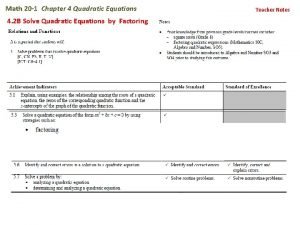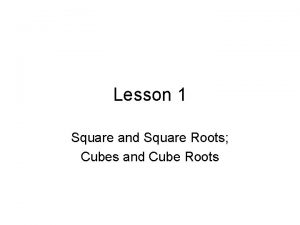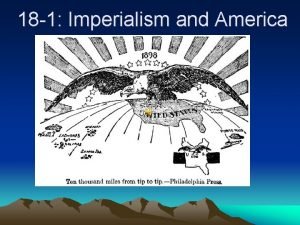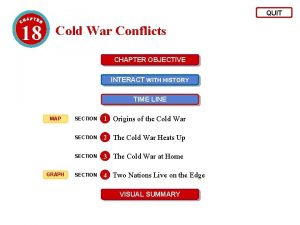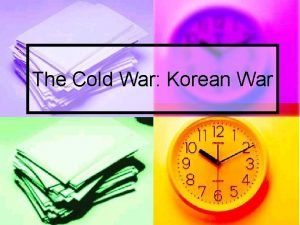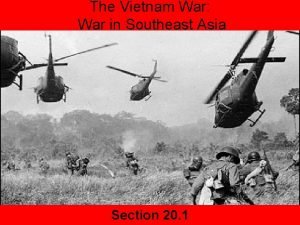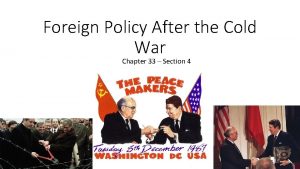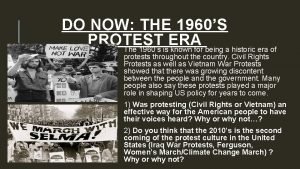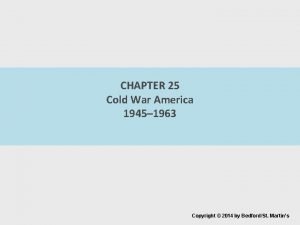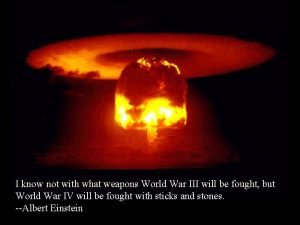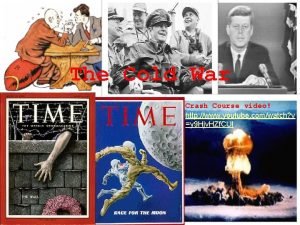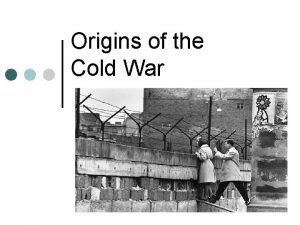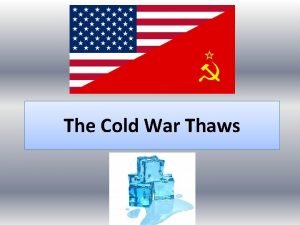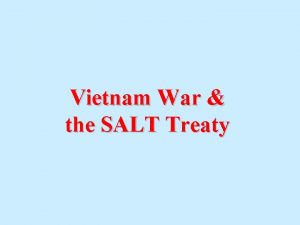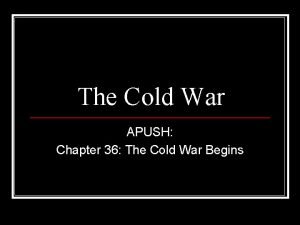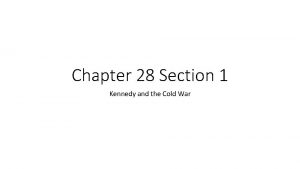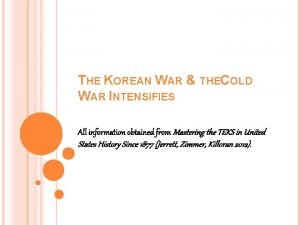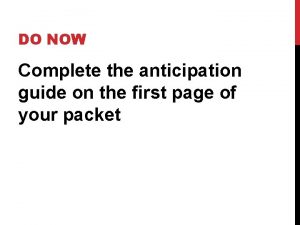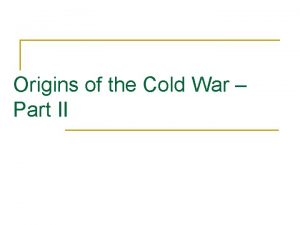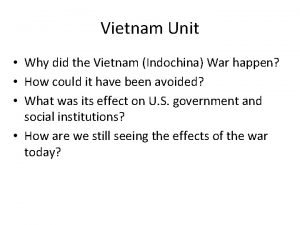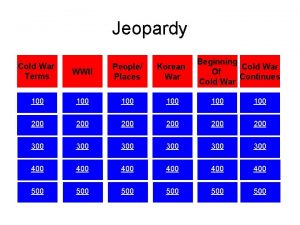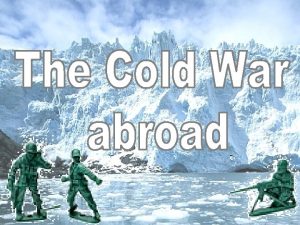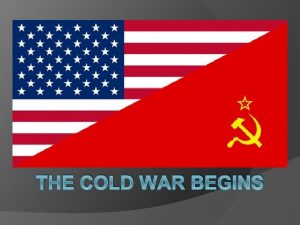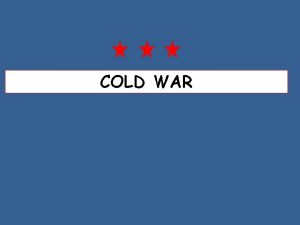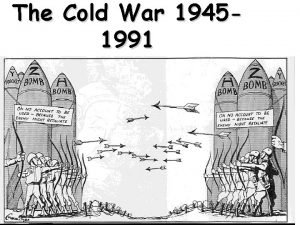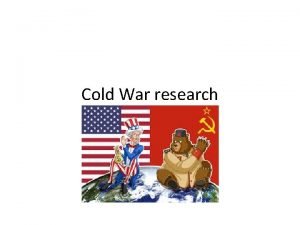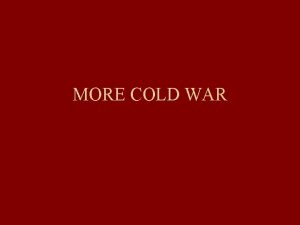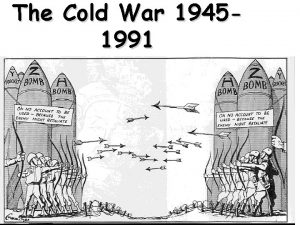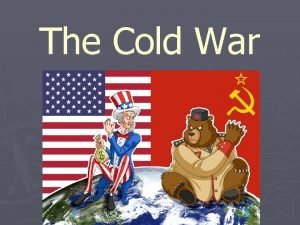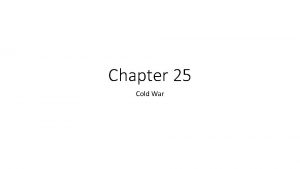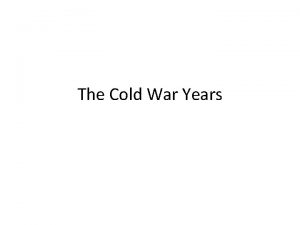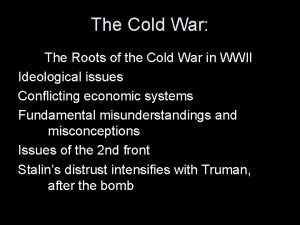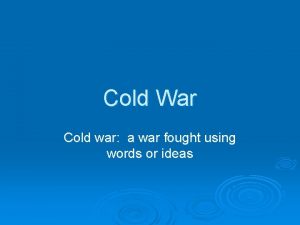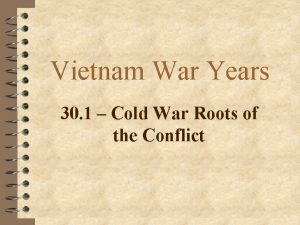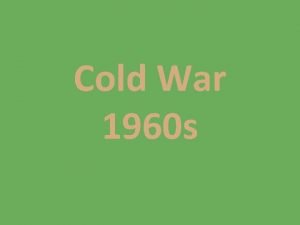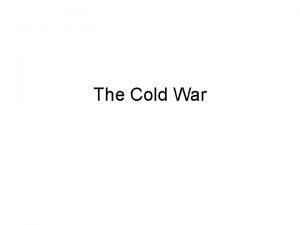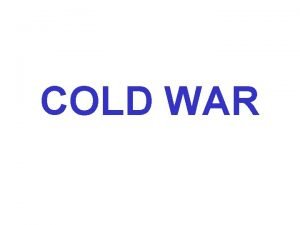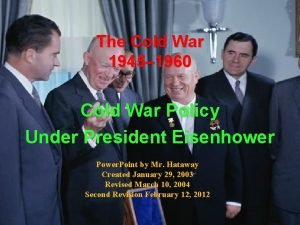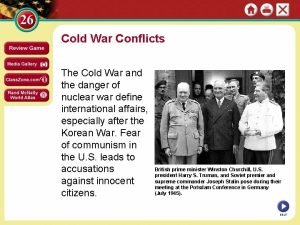The Cold War Roots of the Cold War




























- Slides: 28

The Cold War

Roots of the Cold War Ø Philosophical l Differences Philosophical differences between the Soviet Union and the United States reached back to the 1920 s. • Soviet Union: communism, totalitarian dictatorship • United States: free-enterprise capitalism, republic

Roots of the Cold War Ø World l l l War II Conflicts Allies during the war, but not truly friends Soviets wanted British and Americans to open a second European front earlier in the war. U. S. atomic bomb plans worried Soviet Union.

Roots of the Cold War Ø Postwar l l Conflicts The Soviet Union refused to let Eastern Europe hold elections as promised at Yalta. The United States resisted Soviet expansion.

The Iron Curtain Ø Stalin wanted to retain political and economic control over Eastern Europe. l The Soviets managed to install Communist governments throughout Eastern Europe. • Stalin outlawed political parties or newspapers that opposed the Communists. • The Soviets jailed or killed some political opponents. • The Soviets rigged elections to ensure the success of Communists. l l Yugoslavia was the one Eastern European nation that was not under the direct control of Stalin and the Soviet Union. The Soviet Union relocated Germans living in Poland other countries of Eastern Europe.

The Iron Curtain Ø Western l l l Views of the Iron Curtain Winston Churchill attacked the Soviet Union for creating an Iron Curtain. The term reflected Churchill’s belief that communism had created a sharp division in Europe. Harry S Truman urged his secretary of state to get tough with the Soviets.

The Iron Curtain Ø Soviet l l l Views of the Iron Curtain Stalin believed that the Iron Curtain was necessary to protect the Soviet Union from western attacks. Stalin used Churchill’s words to help persuade his people that the United States and Great Britain were their enemies. He also used this as an excuse to rebuild the military.

How did the United States respond to Soviet actions in Europe? Ø Containment l l l George F. Kennan created a policy known as containment. This policy stated that the United States should resist Soviet attempts to expand its power. Containment included economic aid, sanctions, and military force George Kennan

How did the United States respond to Soviet actions in Europe? Ø Truman l l l Doctrine Said that the United States would help people fight against oppressors Truman wanted to send aid to Greece and Turkey to help them fight Soviet pressure. Congress agreed to send millions of dollars to Greece and Turkey Greece Turkey

How did the United States respond to Soviet actions in Europe? Ø Marshall l Plan An aid program to rebuild the economies of European countries to create stable conditions for democracies 17 countries received $13. 4 billion dollars in aid. Helped build strong political support in Western Europe

Crisis in Berlin Ø With the start of the Cold War, it became clear that the Soviets planned to keep their German zone under Communist control. l l The British, Americans, and French began to take steps to set up a free, democratic government within their German zones. • The western zone eventually became known as the Federal Republic of Germany, or West Germany. The British, Americans, and French also tried to set up a democratic government in West Berlin. • The Soviets were not happy with the idea of a Western-style government and economy in the middle of the Soviet zone of occupation. Map of Berlin after World War II

Crisis in Berlin Ø Soviets l l l Block Traffic In June 1948 the Soviets announced that they would block any road, rail, or river traffic into West Berlin’s residents were cut off from food, coal, and other products. West Berlin was not completely cutoff because it had airstrips. City of West Berlin

The Crisis in Berlin Ø The l l l Berlin Airlift British and American planes began making deliveries to West Berlin. The Berlin Airlift continued for months and months. Finally, the Soviet Union lifted its blockade on May 12, 1949. Berlin Airlift

The Crisis in Berlin Ø NATO l l l Forms In 1949 the U. S. and 6 other nations joined Belgium, France, Luxembourg, the Netherlands, and the U. K. to form NATO. An armed attack against one would be considered an attack against all. Today, 26 countries belong to NATO Countries Flags

Life in America after World War II Ø The l l GI Bill The Servicemen’s Readjustment Act of 1944 was better known as the GI Bill. The bill helped veterans transition to civilian life. • Provided money for vets to attend college or receive advanced job training • Helped arrange for home, farm, or business loans • Provided help in finding work as well as a year’s worth of unemployment benefits

Life in America after World War II Ø Increased l l l Demand for consumer goods rose sharply. Returning vets built houses, which increased the demand for furniture and appliances. A baby boom began as Americans began having families.

Life in America after World War II Ø Labor Unions l l During the war, the government prevented labor disputes. After the war, unions began to seek the increases in wages that were limited during the war. The number of strikes rose sharply. In 1947, Congress passed the Taft-Hartley Act, which greatly reduced the power of labor unions.

Life in America after World War II Ø Racial l l Minorities Truman issued Executive Order 9981, which ended segregation in the U. S. armed forces. Hispanic veterans joined together in the American GI Forum. • They worked to gain full access for Hispanic veterans to benefits earned by their service during the war.

Building a Better World Ø People had a strong desire to understand prevent the causes of war after World Wars I and II. Ø One result was the establishment of the United Nations (UN). l l 50 nations met in June 1945 to create the UN Charter. The Charter committed its members to respect fundamental human rights, respect treaties and agreements, and to promote the progress and freedom of all people. Member nations agreed to live in peace. The Charter called for the use of international organizations to promote economic and social advancement

Trying to Build a Better World Human Rights Ø The UN established the Commission on Human Rights. Ø In December 1948, the commission presented the Universal Declaration of Human Rights. Ø It declared that all human beings are born free and equal. Ø It called for an end to slavery, torture, and inhumane punishment. Ø It demanded a variety of civil rights, including the right to assembly and the right to access the courts. Ø It stated that elementary education should be free and available to all. Trade and Economic Development Ø At a conference in New Hampshire, leaders agreed to create the World Bank and the International Monetary Fund. Ø The World Bank provided loans and grants to countries for the purpose of reducing poverty. Ø The International Monetary Fund promoted orderly financial relationships between countries. Ø It was designed to prevent economic crises and to encourage trade and economic growth. Ø Another international organization, the General Agreement on Tariffs and Trade set rules and regulations for international trade.

The Growing Fear of Communism Soviet Atomic Weapons Ø In September 1949 Truman announced that the Soviet Union had detonated an atomic bomb. Ø This was a shock to the nation. Ø Truman began to strengthen the nation’s military against a possible Soviet nuclear threat. Chiang Kai-Shek Mao Zedong Communist China Ø Communists in China had gained nearly full control of the country. Ø The Nationalist government of Chiang Kai-shek fled to Taiwan Ø China was in the hands of the Communist Party under the leadership of Mao Zedong. Ø Americans worried that China increased the Communist threat to the United States.

Fighting Communism at Home Ø Investing Communism l l l The House Un-American Activities Committee (HUAC) explored the possible Communist influence in the American film industry. The Hollywood Ten refused to answer HUAC questions about their beliefs or those of their colleagues. Many others in Hollywood did testify, for if they didn’t their names were placed on a blacklist. Hollywood Ten

Fighting Communism at Home Ø Truman l l l and Loyalty Truman investigated all federal employees to ensure the loyalty of government officials. The investigations turned up little evidence of disloyalty. This investigation made clear that Truman was serious about fighting communism.

Fighting Communism at Home Ø The l l l Smith Act Truman charged several leaders of the Communist Party in the United States under this act. The act made it a crime to call for the overthrow of the U. S. government. The leaders were convicted and their convictions were upheld in Dennis v. United States.

Fighting Communism at Home Ø The l l Mc. Carran Act This act required Communist organizations to register with the government. It established a special board to investigate Communist involvement. Made it illegal to plan a totalitarian dictatorship Prevented Communists from entering the United States

Fighting Communism at Home Ø Spy l l l Cases Alger Hiss—convicted of being a spy for the Soviets Klaus Fuchs—a Manhattan Project scientist who gave atomic bomb information to the Soviets Ethel and Julius Rosenberg— convicted of passing secrets to the Soviets and executed Alger Hiss Klaus Fuchs Ethel & Julius Rosenberg

Joseph Mc. Carthy and the Second Red Scare Ø Joseph Mc. Carthy was a senator who claimed that there were 205 known Communists working for the U. S. Department of State. l l l Truman dismissed him as a “ballyhoo artist. ” A political cartoonist dubbed Mc. Carthy’s tactic of spreading fear and making baseless charges Mc. Carthyism. Mc. Carthy’s claims were rarely backed up with any evidence, but this didn’t stop him from gaining a reputation as being the nation’s top Communist fighter. Mc. Carthy succeeded when he made a special effort to defeat Maryland senator Millard Tydings. Mc. Carthyism spread beyond the Senate into other branches of government, into universities, into labor unions, and into private businesses.

Mc. Carthy’s Fall Ø Mc. Carthy continued his campaign from the Senate but became increasingly wild in his accusations. • In 1952 he began to go after fellow Republicans l In 1954 he attacked the U. S. Army, claiming that it was protecting Communists. l The public came to view Mc. Carthy’s tactics as unfair. l The fear of communism remained, but Senator Mc. Carthy and Mc. Carthyism faded away.
 The cold war lesson 1
The cold war lesson 1 Quadratic equation
Quadratic equation Perfect square notes
Perfect square notes Perfect squares list
Perfect squares list Lesson 3 existence and uniqueness
Lesson 3 existence and uniqueness The roots of american imperialism 1. economic roots
The roots of american imperialism 1. economic roots Chonp
Chonp Cold war proxy wars
Cold war proxy wars Cold war tension graph
Cold war tension graph Rollback cold war
Rollback cold war Operation rolling thunder cold war
Operation rolling thunder cold war Chapter 33 section 4 foreign policy after the cold war
Chapter 33 section 4 foreign policy after the cold war Doves cold war
Doves cold war Chapter 25 cold war america
Chapter 25 cold war america Cold war
Cold war Weapons of the cold war diagram
Weapons of the cold war diagram Cold war crash course
Cold war crash course The cold war
The cold war Soviet union acrostic poem
Soviet union acrostic poem What does salt stand for cold war
What does salt stand for cold war Cuban missile crisis apush
Cuban missile crisis apush Chapter 28 section 1 kennedy and the cold war
Chapter 28 section 1 kennedy and the cold war Cold war knowledge organiser
Cold war knowledge organiser Chapter 17 section 1 cold war superpowers face off
Chapter 17 section 1 cold war superpowers face off The cold war intensifies
The cold war intensifies Lord of the flies anticipation guide
Lord of the flies anticipation guide Origins of the cold war
Origins of the cold war Napalm vietnam war
Napalm vietnam war Jeopardy cold war
Jeopardy cold war

